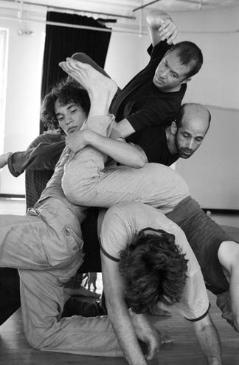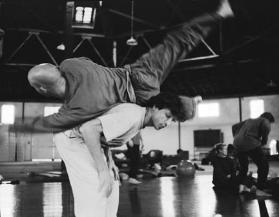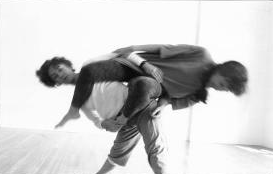Contact Improvisation
Contact Improvisation challenges easy definition. In addition to identifying it as experimental dance, practitioners have called it art-sport, folk dance, meditation, therapy, play, and a technique for choreography. As an improvisational dance, partners continually stay in touch with each other’s body while sharing weight.
Moving Touch
In the early 1900s, a doctor with a Baltimore orphanage was puzzled by its high mortality rates. Despite receiving regular feedings and diaper changes, many infants died within months of their admission. A similar trend noted at orphanages across the country and in Europe spawned a study to determine the cause. Researchers learned that the difference between life and death for infants came down to a single factor: the amount of human touch received. Subsequent studies have revealed that touch provides innumerable benefits not only for infants, but for adults as well. Touch relieves stress, stimulates nerves, bolsters immune systems, reduces physical and emotional pain, and increases concentration. None of this information is new to bodyworkers. They well know the therapeutic value of touch and use it to treat a wide array of discomforts and diseases, everything from muscle strain and depression to autism and dementia.
Touch puts us in touch. Touch steers our attention to the largest organ of our body, our skin, with its myriad nerve endings. Touch brings attention to our physical self while simultaneously highlighting our emotions, thoughts, and relationship with the world. Our skin both separates and links us to what lies beyond us. When a friend or family member rests her hand on our shoulder or arm, we feel her presence and feel, too, our response.
For years, I’ve been practicing and teaching a form of dance called Contact Improvisation in which touch plays a major role. Dancers partner in an improvisational exchange of weight and balance, consistently maintaining sites on their bodies where they rely on each other to roll, spiral, lift, and slide along the contours of each other’s bodies. The dance was developed in 1972 by dancer and choreographer Steve Paxton. His intention was to further the vocabulary for partnering in contemporary dance and choreography. Since his initial exploration, the dance, frequently described as art-sport, physical dialog, meditation, creative play, a choreographic technique, and therapy, has mushroomed into a world-wide practice enjoyed primarily by people outside the circle of professional dancers.
The majority of Contact Improvisation practitioners who gather for “jamming” are comprised of movement enthusiasts from such diverse backgrounds as computer programming, carpentry, bodywork, biochemistry, social work, and, of course, dance. Reasons for partaking in this partnered dance vary. Participants enjoy the dance because it is athletic, relaxing, stimulating, centering, playful, therapeutic, social, provocative, and fun.
After more than twenty years, I am still amazed by the richness of this form. Contact Improvisation builds strength, increases flexibility, elicits joy, and stimulates genuine self-reflection. Dancers roll across the floor, spiral around a partner’s shoulder, or tumble over a back, in slow or fast motion, one moving body offering another moving body support. To accomplish these maneuvers requires trust. Through contact, practitioners awaken to an increased range of motion and an inner life. The dance, potent in its combination of touch with motion, rarely leaves a dancer unmoved.
This article was originally published in Natural Awakenings.
My story: Dance for Life
In this video, I share my personal narrative about how a diagnosis of scoliosis led to contact improvisation and teaching dance.
How do beginners practice contact improvisation?
Movements arise from a reflexive relationship with a partner, not a preconceived ideal. No one tells the dancer what moves to perform, in what sequence, for how long, and with whom. Like a writer’s blank page, the dance floor, though it may be peopled by fellow dancers, remains unscripted.
How do partners start a dance?
A common beginning exercise is to sit on the floor back to back with a partner. Feel the sensations in your back in the places where you touch each other. Breathe and relax. Notice any small movements taking place. When ready, explore the contact with movements such as pressing, sliding, and rolling. Stay in touch at all times. Find out what is possible.



